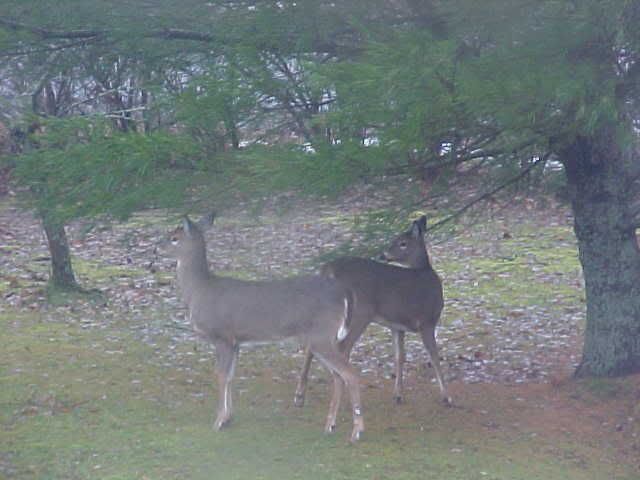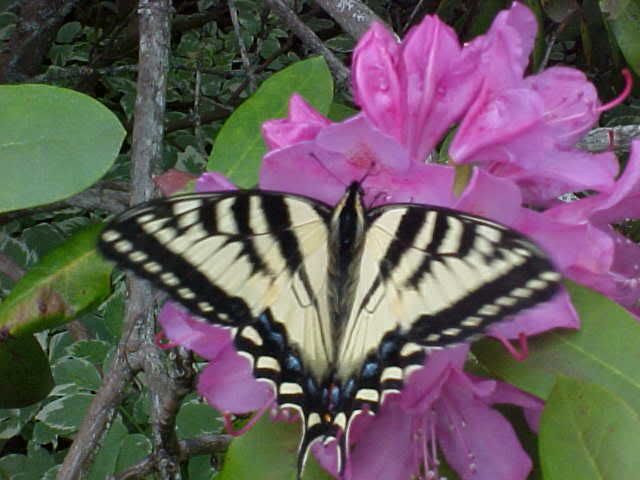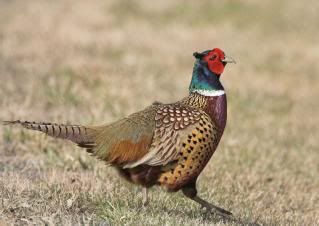We have created a tiny 'preserve' for them at the base of the property and baited the area with various foods that will help the animals over the winter. Our favourites are the white-tailed deer as they wander the orchard areas and accept the deadfalls and pumpkins we leave for them. This is a doe with her fawn from the spring of 2008.
This is a porcupine that entered the property in the fall of 2009. Since they are dangerous to the cats because of the quills, David removed him twice to the Caseylands, but he would not stay away. He ate apples for a week, and then one morning I found him dead. When I examined him I discovered tumours where his left hind leg met his abdomen, so I buried him realizing that he had come here to end his days with easy food in a sheltered place. There's always a surprise.
Tiger swallowtail butterflies do well here, feeding on honeysuckle blossoms and other red, pink and purple plants. They lay eggs in the hedges and in the loft of our barn, and we also see larva climbing the interior walls of the barn in the autumn. They must taste bad because the hens and cats leave them alone. Then in June, hundreds of adults emerge and flood the acreage.
We see raccoons of course, and a female named Mary often joins the cats in the barn. I knew her as an infant, and I suspect one of the cats brought her here. Other local mammals include pine martens ( we're in a protection zone), weasels, mink, bobcat, red foxes, eastern coyotes and black bear. We're in the middle of the Atlantic Migratory Fly Zone and see sparrow hawls, red tails, peregrines, various owl species, eagles and osprey. Reptiles include brown snakes, red racers and garter snakes. We hear spring peeper frogs early in spring. Keeping some of the predators separated from the hens is vital.
Ringneck pheasants are an introduced species in Nova Scotia and the Caseylands across the road from here were used as a breeding site. In fall and winter the males yard up and are conspicuous in flocks throughout the area. The hens are doing the same thing, but are in muted plumage and safer from hunters. One male we call 'Bluster' attracts his harem to our property in spring and also romances our hens by dancing and singing outside their run. They are most impressed with this and call back. Hybrids can and do result from pheasant/chicken crosses but are usually sterile.
The eastern coyote was first noted in Nova Scotia in the 1970's as the red wolf of New Brunsick was in decline. It is speculated among wildlife experts that this animal is a hybrid perhaps of dog and wolf. DNA research continues as the eastern cotoye becomes a ubuquitous sight throughout the province. It is bold near human habitation and has been blamed for a human death in Cape Breton. As of the autumn of 2010, bounties are offered to professional trappers, but sadly, the are permitted to use leg and shoulder traps.
The red fox is not closely related to wolves or coyotes but its habits are similar. We have many of there lovely creatures in Rawdon because of loose glacial till and shafts from former gold mines. I have had a fox come into the back of the barn as I swept the floor and grab a kitten. Another time one chased an orange cat up my body and 'sat pretty' three feet away waiting for me to let the cat go. Glad I had a walking stick to shoo her away. But I ended up with cat urine on one shoulder and a bloody scalp- thank you, Butternut.
The black bear can become entirely too comfortable with human food, and if anyone carelessly puts fat or protein in the green bin more than a day, it is likely to be raided. Most of us freeze our leftovers so bears will avoid us, then throw it out in the bin on collection day. A bear can destroy a coop and trash the interior of a barn. Most people don't realize they are avid carnivores, not so bad as a grizzly, but opportunistic in the extreme, and they love chicken. In July when the young males are driven from their mothers they are a particular hazard. Our tend to frequent the river canyon of the Herbert, but emerge as it suits them. The last time we were on the Elliott Road bridge, taking photos, we smelt a pile of spore and turned to see it steaming ten feet away. The bear had been that close and was probably watching us.
As cute as they may seem, raccoons are one of our most serious predators. They like eggs and will reach in chicken pens and literally rip a chicken to pieces. Small gauge strong wire is needed to protect the birds. As well, raccoon distemper is rampant, and this summer the neighbourhood had trouble with an immense boar who was ill. Not only did he try to destroy a screen door at the house next to us, he killed several pets. I suspect he is responsible for the loass of 5 adult cats and several kittens. Fortunately raccoon distemper is a different disease from cat or dog distemper. The only raccoon I trust is Mary, who was brought to our barn as an infant and who was raised by our female cats. She visits from time to time and is content to be calm among the farm creatures and me. I didn't handle her, though, because of the chance that as an adult her temperament might not have held.
Pine martens look like cats, from a distance. A protection program exists here and we are in no position to harm one even if it becomes a nuisance. The good news is that they hunt rodents and help to keep the farmlands clear of them. They nest high in trees and some of the release boxes can be seen on the banks of the Herbert River, in pine trees. To keep birds safe you must have a roofed run with small gauge hardware cloth above and below ground.
Bobcats are occasionally sighted here and lynxes live deeper in the woods. There is a skunk bunker under the old outhouse. We have spring peeper frogs and various reptiles including snapping turtles, red racers, brown and garther snakes. We see a lot of hawks, ravens, crows, falcons, eagles and osprey. Occasionally an owl will hunt on the property.
It's our job to protect our hens, so we do everything possible to enclose them. Free-ranging is a romantic concept this close to the woods.









Hi Lynne, beautiful photos!
ReplyDeleteKind regards Mandy x